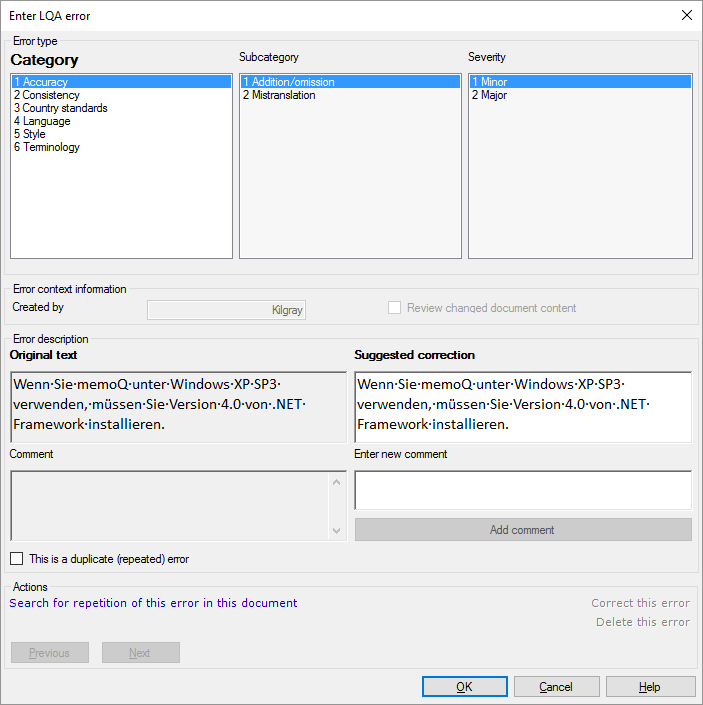|
memoQ knows about Linguistic Quality Assurance. This is a way of adding human feedback to documents. The human reviewers can structure and formalize their feedback, and grade the translations if necessary. You use the LQA options - LQA models - to enter these and report about them. An LQA model defines error categories. You can use these to score the errors, grade the translations. Some models allow you to fail a translation. There are several standards about LQA. memoQ supports tbree of these: J2450, LISA, and TAUS. In addition, memoQ introduces yet another LQA model of its own. In this window, you can either enter a linguistic quality assurance (LQA) error, or view the details of an existing one. For each segment, there several LQA errors. Some of these errors can become QA warnings, too. The details you can enter depend on the linguistic quality assurance (LQA) model of the document. When you import a document, it will use the LQA model of the project. However, if the document was imported as a memoQ XLIFF document from another project, it may bring a different LQA model. To check the LQA model of the project: In Project home, choose Settings. Click the LQA models tab. Check which LQA model has its check box checked. To see what is in the LQA model, edit it, or - if it is a default LQA model - clone it, and then edit the clone. How to get here1.Open a project. Make sure it has an LQA model. LQA models can be added late: If you choose an LQA model after the documents were imported, memoQ will add the LQA model to the documents - unless they had a different LQA model previously. 2.Open a document for editing. This will work if the document has an LQA model. To add a new LQA error: 3.In the translation editor, start reviewing the segments. 4.Reject a segment that needs improvement: press Shift+Enter. To view an existing LQA error: 3.Click a rejected segment. (It has a red background.) 4.At the bottom, point at the View pane. Click the Review tab. memoQ will show the LQA errors and the QA warnings for the segment. 5.Next to an LQA error, click the Edit The Enter LQA error window opens.
What can you do?
When you finishTo add or change the error report, and return to the translation editor: Click OK. Or, to return to the translation editor without adding the error: Click Cancel. If you receive a document that has rejected segments, you can review them: 1.At the top of the translation grid, click the Filter 2.Click the Status tab. At the bottom, check the Rejected check box. memoQ will show the rejected segments only. 3.Click a rejected segment. At the bottom, point at the View pane. (If you cannot see the View pane, use the View ribbon to reveal it.) Click the Review tab. 4.memoQ will list the LQA errors in the segment. Point at an LQA error report. Two or three icons will appear on the right. 5.You can accept the correction: Click the Accept If you work as a Reviewer 2, you can delete the error: Click the Delete To get a report about the LQA errors: On the Document ribbon, click LQA Reports. The LQA reports window opens. Choose which part of the project you want to report on, and then click Calculate. To learn more, see Help about the LQA reports window. |
